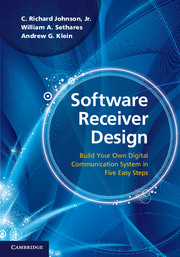Book contents
- Frontmatter
- To the Instructor …
- Contents
- Dedication
- Step 1 The Big Picture
- Step 2 The Basic Components
- Step 3 The Idealized System
- 4 Modeling Corruption
- 5 Analog (De)modulation
- 6 Sampling with Automatic Gain Control
- 7 Digital Filtering and the DFT
- 8 Bits to Symbols to Signals
- 9 Stuff Happens
- Step 4 The Adaptive Components
- Step 5 Putting It All Together
- Appendices
- Index
8 - Bits to Symbols to Signals
from Step 3 - The Idealized System
Published online by Cambridge University Press: 05 June 2012
- Frontmatter
- To the Instructor …
- Contents
- Dedication
- Step 1 The Big Picture
- Step 2 The Basic Components
- Step 3 The Idealized System
- 4 Modeling Corruption
- 5 Analog (De)modulation
- 6 Sampling with Automatic Gain Control
- 7 Digital Filtering and the DFT
- 8 Bits to Symbols to Signals
- 9 Stuff Happens
- Step 4 The Adaptive Components
- Step 5 Putting It All Together
- Appendices
- Index
Summary
Any message, whether analog or digital, can be translated into a string of binary digits. In order to transmit or store these digits, they are often clustered or encoded into a more convenient representation whose elements are the symbols of an alphabet. In order to utilize bandwidth efficiently, these symbols are then translated (again!) into short analog waveforms called pulse shapes that are combined to form the actual transmitted signal.
The receiver must undo each of these translations. First, it examines the received analog waveform and decodes the symbols. Then it translates the symbols back into binary digits, from which the original message can, with luck, be reconstructed.
This chapter briefly examines each of these translations, and the tools needed to make the receiver work. One of the key ideas is correlation, which can be used as a kind of pattern-matching tool for discovering key locations within the signal stream. Section 8.3 shows how correlation can be viewed as a kind of linear filter, and hence its properties can be readily understood both in the time and in the frequency domain.
Bits to Symbols
The information that is to be transmitted by a communication system comes in many forms: a pressure wave in the air, a flow of electrons in a wire, a digitized image or sound file, the text in a book. If the information is in analog form, then it can be sampled (as in Chapter 6).
Information
- Type
- Chapter
- Information
- Software Receiver DesignBuild your Own Digital Communication System in Five Easy Steps, pp. 152 - 164Publisher: Cambridge University PressPrint publication year: 2011
